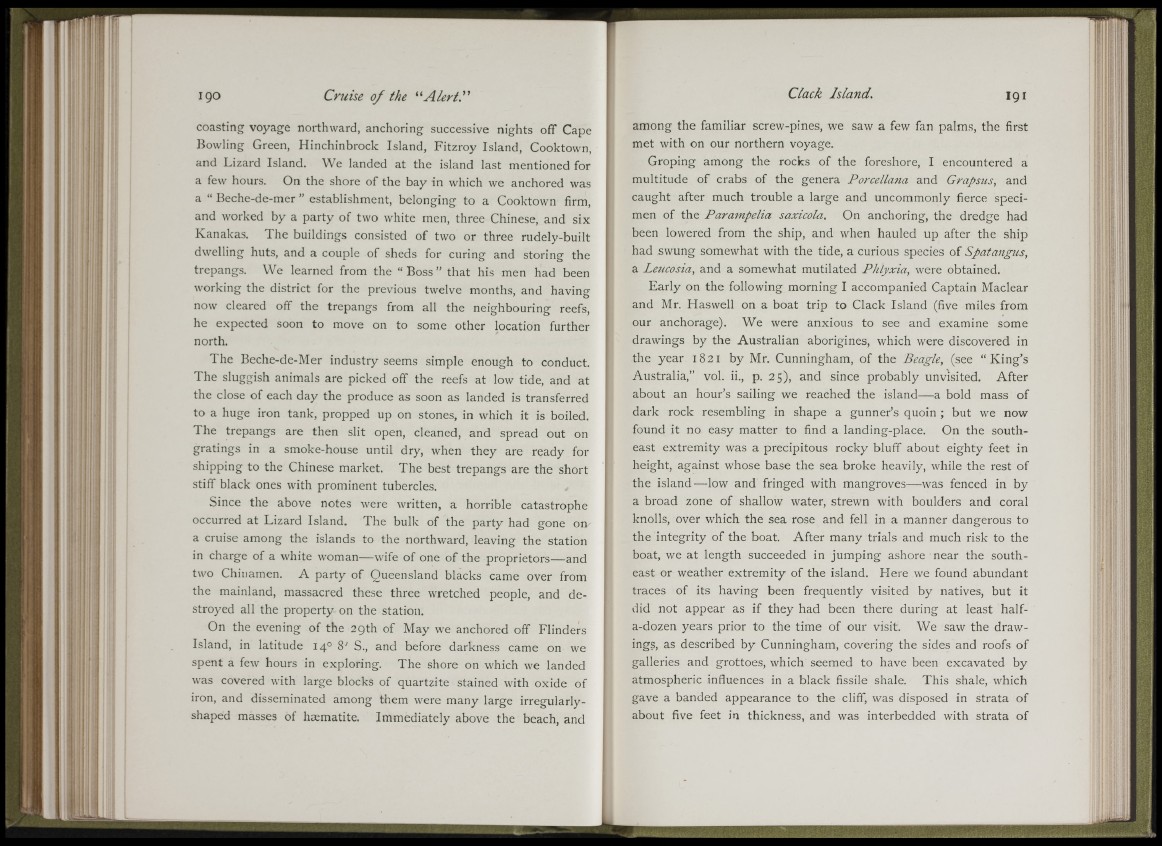
■JS '■
1; . Ill
lUI
i l l
3i
‘i .till
id
; Ji..
<! .ill
■ if
il' -
I: i
It il IJ ‘ !5
“ I”'-
;M!!|
É;íi:i ‘II
j|ii
I
IIf
coasting voyage northward, anchoring successive nights off Cape
Bowling Green, Hinchinbrock Island, Fitzroy Island, Cooktown,
and Lizard Island. We landed at the island last mentioned for
a few hours. On the shore of the bay in which we anchored was
a “ Beche-de-mer ” establishment, belonging to a Cooktown firm,
and worked by a party of two white men, three Chinese, and six
Kanakas. The buildings consisted of two or three rudely-built
dwelling huts, and a couple of sheds for curing and storing the
trepangs. We learned from the “ Boss ” that his men had been
working the district for the previous twelve months, and having
now cleared off the trepangs from all the neighbouring reefs,
he expected soon to move on to some other location further
north.
The Beche-de-Mer industry seems simple enough to conduct.
The sluggish animals are picked off the reefs at low tide, and at
the close of each day the produce as soon as landed is transferred
to a huge iron tank, propped up on stones, in which it is boiled.
The trepangs are then slit open, cleaned, and spread out on
gratings in a smoke-house until dry, when they are ready for
shipping to the Chinese market. The best trepangs are the short
stiff black ones with prominent tubercles.
Since the above notes were written, a horrible catastrophe
occurred at Lizard Island. The bulk of the party had gone on-
a cruise among the islands to the northward, leaving the station
in charge of a white woman— wife of one of the proprietors— and
two Chinamen. A party of Queensland blacks came over from
the mainland, massacred these three wretched people, and destroyed
all the property on the station.
On the evening of the 29th of May we anchored off Flinders
Island, in latitude 14° 8' S., and before darkness came on we
spent a few hours in exploring. The shore on which we landed
was covered with large blocks of quartzite stained with oxide of
iron, and disseminated among them were many large irregularly-
shaped masses of haematite. Immediately above the beach, and
among the familiar screw-pines, we saw a few fan palms, the first
met with on our northern voyage.
Groping among the rocks of the foreshore, I encountered a
multitude of crabs of the genera Porcellana and Grapsus, and
caught after much trouble a large and uncommonly fierce specimen
of the Parampelia saxícola. On anchoring, the dredge had
been lowered from the ship, and when hauled up after the ship
had swung somewhat with the tide, a curious species of Spatangus,
a Leucosia, and a somewhat mutilated Phlyxia, were obtained.
Early on the following morning I accompanied Captain Maclear
and Mr. Haswell on a boat trip to Clack Island (five miles from
our anchorage). We were anxious to see and examine some
drawings by the Australian aborigines, which were discovered in
the year 1821 by Mr. Cunningham, of the Beagle, (see “ King’s
Australia,” vol. ii., p. 25), and since probably unvisited. After
about an hour’s sailing we reached the island— a bold mass of
dark rock resembling in shape a gunner’s quoin ; but we now
found it no easy matter to find a landing-place. On the southeast
extremity was a precipitous rocky bluff about eighty feet in
height, against whose base the sea broke heavily, while the rest of
the island— low and fringed with mangroves— was fenced in by
a broad zone of shallow water, strewn with boulders and coral
knolls, over which the sea rose and fell in a manner dangerous to
the integrity of the boat. After many trials and much risk to the
boat, we at length succeeded in jumping ashore near the southeast
or weather extremity of the island. Here we found abundant
traces of its having been frequently visited by natives, but it
did not appear as if they had been there during at least half-
a-dozen years prior to the time of our visit. We saw the drawings,
as described by Cunningham, covering the sides and roofs of
galleries and gi'ottoes, which seemed to have been excavated by
atmospheric influences in a black fissile shale. This shale, which
gave a banded appearance to the cliff, was disposed in strata of
about five feet in thickness, and was interbedded with strata of